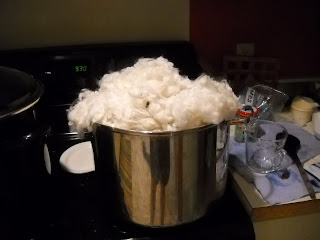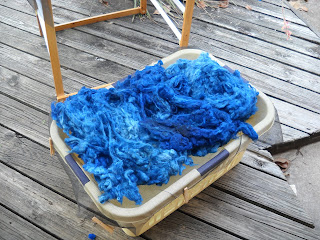I am dyeing some wool fleece in 1 lb lots (18 lbs total, this round) for a rugmaker in west Texas. This is my first time to do fleece, & it has been an adventure! The requested colors are very pale baby blue, periwinkle, & steel gray-blue.
I am finding that it's easier to get a dark, saturated dyelot than a pale one!
The process involves several steps:
1. Soak the fleece, in net bags, 1 lb. each, in the washer. This is usually an all-day or overnight process.
2. Place damp/wet fleece in a large stock pot with acid dye. In order to get very pale, I am using .5 grams of acid dye for 1 lb of fiber. Half a gram of acid dye is a tiny amount! Here it is weighed out on my triple beam balance scale.
Here is the fiber starting to "strike," or take on the dye color.
After the fiber has completely absorbed the dye, & the water has cooled enough to handle the pot, I take the pot outside & dump the fleece into a large tulle netting bag that I constructed for this purpose. The bags are suspended from the magnolia tree in my front yard. This is one of the blessings of fiber dyeing in Texas: It's soooo HOT that fiber can dry relatively quickly.
But overall, wet fleece is like a giant sponge & water must be pressed out of the bag every few hours.
After a few hours minimum, I dump the fleece into a rigged up drying rack for more solar-aided drying.
The fleece you see here is quite dark, darker than the speced samples that the customer requested. But you can see the process, anyway!
Here are the finished, dry fleeces in their bags ready for the rugmaker. The dye doesn't take very evenly, but it will all even out in the combing & wrapping process.
I constructed/created tools out of yards of nylon tulle & also a roll of screening from Home Depot, a drying rack contributed by my friend George (who got it at a garage sale), a large laundry basket, two large stockpots. I also use wooden spoons, a gallon container for adding water to the dyebath, my triple-beam balance scale, & so on. Also, I am assisted by the 100+ F days here in Texas, because wet fleece doesn't voluntarily give up its water!










